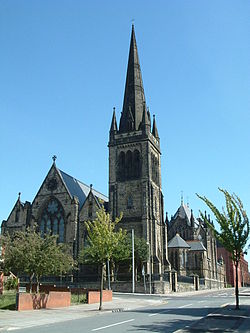- Church of Saint Francis Xavier, Liverpool
-
Church of Saint Francis Xavier, Liverpool 
Church of Saint Francis Xavier, Liverpool53°24′48″N 2°58′11″W / 53.4132°N 2.9698°WCoordinates: 53°24′48″N 2°58′11″W / 53.4132°N 2.9698°W Location Salisbury Street, Everton, Liverpool Country England Denomination Roman Catholic Website http://www.sfxchurchliverpool.com/index.php Architecture Status Parish church Functional status Active Heritage designation Grade II* Architect(s) J. J. Scoles, Edmund Kirby Architectural type Church Style Gothic Revival Groundbreaking 1842 Completed 1887 Specifications Materials Stone with slate roofs Administration Diocese Liverpool Clergy Priest(s) Fr. Patrick Connors, SJ The Church of Saint Francis Xavier, Liverpool is a Roman Catholic church in Salisbury Street, Everton, Liverpool, England (grid reference SJ356911). It is a Grade II* listed building[1] and an active parish church in the Archdiocese of Liverpool and the Pastoral Area of Liverpool North.[2] It is staffed by the Society of Jesus.[3]
Contents
History
Members of the Society of St Francis Xavier decided at a meeting in 1840 that, as the numbers of Roman Catholics in Liverpool was growing rapidly, a new church was needed.[4] The foundation stone was laid in 1842 and J. J. Scoles was appointed as architect.[5] The church opened on 4 December 1848.[3] The spire was added in 1883.[5] The church had been designed to hold 1,000 people but this proved to be insufficient for the congregation and in 1888 an additional chapel, the Sodality Chapel which had been designed by Edmund Kirby, was opened.[3] In 1898 the wall dividing the Sodality Chapel from the main part of the church was demolished.[6]
By the time of the Second World War, St Francis Xavier's was the largest Roman Catholic parish in England, containing over 13,000 Catholics.[3] During the war the church was damaged, particularly the roof, and most of the windows were blown out.[7] From the 1960s the church went into decline, partly because of the demolition of housing in the parish. In the 1980s there were plans to demolish the nave, but it was saved following a popular campaign. In 2001 the parish was combined with the parishes of St Joseph and St Mary of the Angels and the Sodality Chapel was re-named The Chapel of St Mary of the Angels and St Joseph.[3]
Structure
The church is built in stone with slate roofs. Its plan consists of an eight-bay nave with north and south aisles under separate gabled roofs, and a short one-bay chancel with chapels to the north and south. To the southwest is a tower with a spire and to the southeast is the Sodality Chapel. This chapel is polygonal in plan with apse at the west and an ambulatory at the east end.[1][5]
Fittings and furnishings
The high altar and reredos are in white marble and include arcades and pinnacles; they were designed by S. J. Nicholl. In the side chapels are similar altars and reredoses. The pulpit is made of Caen stone and an elaborate font is at the west end of the nave.[1] Stained glass windows in the church are by Hardman and Powell, dated 1930, and by Linda Walton, dated 1999. The stained glass in the Sodality Chapel was designed by Edmund Kirby and made by Burlison and Grylls.[5] The ring consists of eight bells cast in 1920 by John Taylor & Co.[8] which were re-hung in 2002–03.[citation needed] The four-manual organ was built in 1849 by Gray & Davison and rebuilt and enlarged in 1907 by William Hill & Son.[9]
Present day
The church holds services on Sundays and throughout the week.[10] The bells are rung by the Liverpool Universities Society of Change Ringers.[11]
During 2008 to celebrate Liverpool being the European Capital of Culture an exhibition was held in the church entitled Held in Trust: 2008 Years of Sacred Culture. This consisted of artefacts from Stonyhurst College, embroideries and church plate from the church's own collection, and vestments from the chapel in the Portuguese Embassy in London. Items on display included a book of homilies of Pope Gregory from 1170, Thomas More’s hat, Katherine of Aragon’s chasuble, and Cardinal Wolsey’s Book of Hours.[12]
References
Notes
- ^ a b c Images of England: Roman Catholic Church of St Francis Xavier, English Heritage, http://www.imagesofengland.org.uk/details/default.aspx?pid=1&id=359442,, retrieved 12 November 2008
- ^ Liverpool North (Pastoral Area 1), Archdiocese of Liverpool, http://www.archdiocese-of-liverpool.co.uk/parishes/01liverpoolnorth.html, retrieved 12 November 2008
- ^ a b c d e Parish History, St Francis Xavier's Church, http://www.sfxchurchliverpool.com/history/historymain.php, retrieved 12 November 2008
- ^ Kennedy 2006, p. 1.
- ^ a b c d Pollard, Richard; Nikolaus Pevsner (2006), The Buildings of England: Lancashire: Liverpool and the South-West, New Haven & London: Yale University Press, pp. 418–419, ISBN 0 300 10910 5
- ^ Kennedy 2006, p. 5.
- ^ Kennedy 2006, p. 9.
- ^ Liverpool, S Francis Xavier, Dove's Guide for Church Bell Ringers, http://dove.cccbr.org.uk/detail.php?searchString=Liverpool%2C+SFX&Submit=++Go++&DoveID=LIVERPL+SF, retrieved 12 November 2008,
- ^ Liverpool, St Fancis Xavier, British Institute of Organ Studies, http://www.npor.org.uk/cgi-bin/BOASearch.cgi?Fn=GSearch&boa_ref=8295&, retrieved 25 April 2009
- ^ Masses and Services, St Francis Xavier's Church, http://www.sfxchurchliverpool.com/masses.php, retrieved 12 November 2008
- ^ What is LUSCR?, Liverpool Universities Society of Change Ringers, http://www.homepages.ucl.ac.uk/~uccalsp/luscr/info.html, retrieved 24 October 2009
- ^ Capital of Culture Exhibition, St Francis Xavier's Church, http://www.sfxchurchliverpool.com/capital_of_culture_exhibition.php, retrieved 12 November 2008
Bibliography
- Kennedy, Johnny (2006), St Francis Xavier's, Liverpool: 1848–1998, http://www.sfxchurchliverpool.com/book/intro.php
Categories:- Grade II* listed buildings in Liverpool
- Grade II* listed churches
- Roman Catholic churches in Liverpool
Wikimedia Foundation. 2010.
